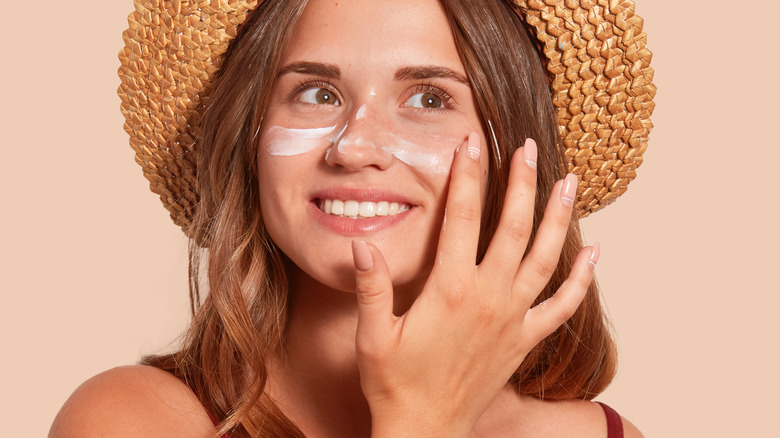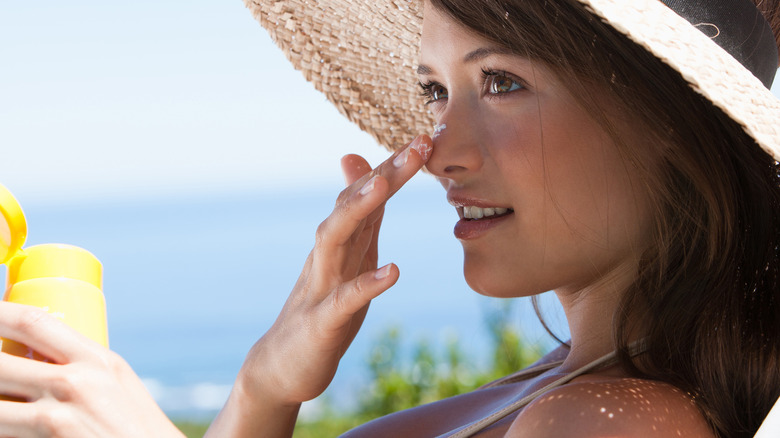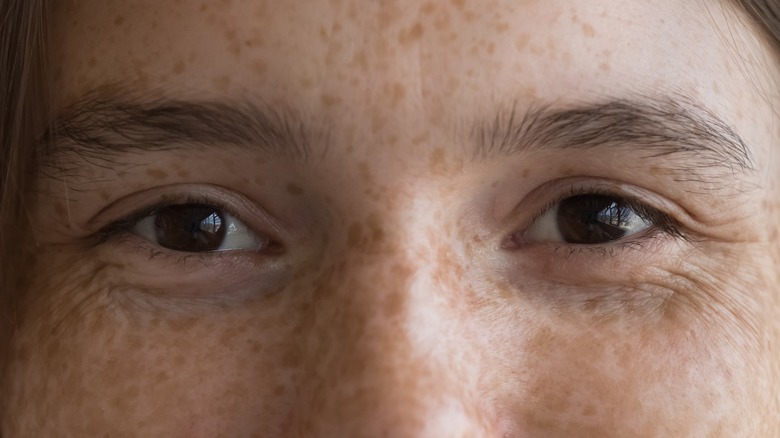Don't Make This Common Sunscreen Mistake
Sunscreen is the first port of call when it comes to skincare, and an indispensable item in every woman's handbag, rain or shine. Not only does wearing sunscreen protect your skin from sunburn and blotchy complexion, but it also prevents premature aging as a result of photodamage, per Scripps. It also boosts the production of collagen to keep your skin youthful. Using sunscreen accurately and regularly also helps lower risks of cancer, including the most lethal type, melanoma, according to Craig Sinclair from Cancer Council Australia. Therefore, it's important to slather on a "broad spectrum sunscreen that blocks both UVA and UVB rays and has an SPF of 15 or higher before you go outside," Centers for Disease Control and Prevention advises.
While you may believe that most of us understand how to use sunscreen to our benefit because the practice has been around for a long time, you may be surprised to discover that many of us have been applying sunscreen incorrectly, which reduces the product's efficacy on our skin. The following are some typical sunscreen blunders that jeopardize the UV protection we should be obtaining.
Most people apply sunscreen too thinly
Turns out, the way sunscreen is applied plays a vital role in determining how effective it is. A common mistake that many people make is to only apply 25 to 50% of the recommended amount of sunscreen, clinical professor of dermatology at NYU Dr. Darrel Rigel tells CBS News. It takes one ounce of sunscreen to cover your whole body, including all the areas that are exposed to UV rays.
To make sure you're getting adequate protection, apply a quarter-size quantity to your face and neck, as well as the area behind your ears, temples, and hairline. Sunscreen producers often recommend applying the cream with a thickness of 2 milligrams per square centimeter of skin, and this is the quantity that the experts use as a benchmark for determining the product's sun protection factor (SPF), per The Guardian.
"People are typically getting much less protection than they think," explains professor of experimental photobiology at King's College London Antony Young tells The Guardian. "For example, if you get SPF20 and use at a lower thickness of 0.75 milligrams per centimetre squared, your level of protection could be as low as SPF4." If you want to use less than the recommended amount, you need to use sunscreen with higher SPF to compensate for the thin application.
There's no such thing as too much sunscreen. Therefore, be generous in your application to keep your skin protected from the sun.
Key spots where people forget to apply sunscreen
Applying sunscreen thinly is one thing, but consistently forgetting to apply sunscreen to certain areas of your body is a whole other ball of wax. The eyelids and lips are two key spots that sunscreen users frequently ignore (via Cleveland Clinic). Lips and eyelids are equally as exposed to sun radiation as the rest of your body, putting them at risk of developing skin cancer. Many people, however, neglect or skimp on applying sunscreen to these areas. According to Renaissance Dental, exposing bare lips to the sun's UV rays can put you at danger of sunburn and skin or oral cancer. This is particularly true of the bottom lip. To protect your lips, use a lip sunscreen with an SPF of 30 or more or a hydrating SPF lip balm.
When applying sunscreen around your eyes, always remember to include your eyelids. According to a 2019 study published in PLOS One, the chances of eyelid skin cancer are higher among persons who do not cover their eyelids with adequate sun protection. Wearing sunscreen not only reduces the danger of sun damage and skin cancer, but it also lowers the creation of wrinkles on thin eyelid skin and prevents dark circles from appearing around the eyes. For full-on sun protection, apply sunscreen at least 15 minutes before heading out, paired with additional protection such as wide-brimmed hats or long-sleeved jackets. Then reapply sunscreen every two hours while outdoors.


